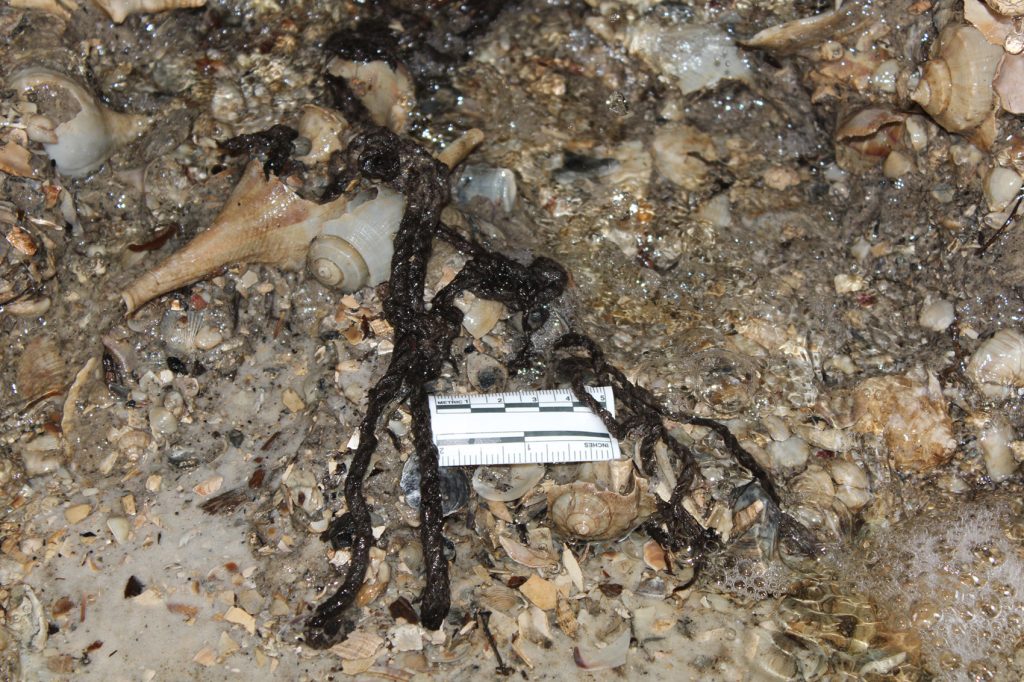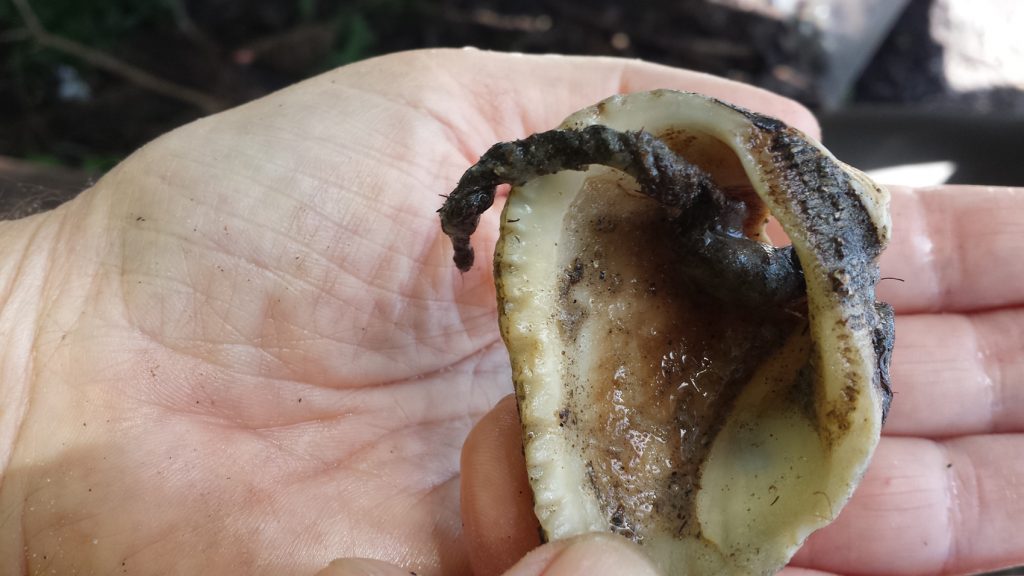It is impossible to do any archaeological work in Southwest Florida without thinking about Frank Hamilton Cushing, the brilliant and flamboyant archaeologist who excavated the famed Key Marco site in 1896.
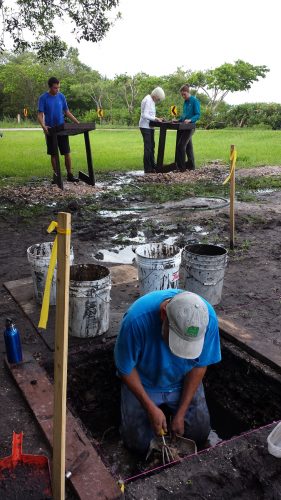
That site was located on Marco Island in present-day Collier County, but regular readers know that Cushing also visited Pineland three times in 1895 and 1896, describing the mounds, courts, and canals, and making three sketches that have helped us piece together the appearance of the site before twentieth-century disturbances began. Karen Walker and I were particularly reminded of Cushing and Key Marco in late July and early August of this year when we worked with RRC volunteers at the Pineland Site. The two weeks of field work took place in the front yard of the Wilson Sisters’ House, the historic 1920s home situated at the corner of Pineland Road and Waterfront Drive.
The Wilson Sisters’ House, a garage apartment, and the house on top of Randell Complex Mound 2 are all part of rental property owned by the Randell family. Unfortunately, the old septic system was failing, so a new tank and drainfield were needed. The drainfield would not require a deep excavation, but the tank was to take up a volume about 8 x 10 feet and up to 5 feet deep. The property lies within the Pineland Site Complex National Register district, which is also a Lee County designated historical district. An archaeological investigation would have to be done before the tank could be installed. Although we had not planned to do any fieldwork in July and August, Karen and I agreed to undertake an investigation of the area. I proposed a series of shovel tests, followed by a controlled archaeological excavation, and also proposed to monitor the installation of the pump lines and the leveling for the drainfield. Karen and I worked a total of 11 days at the job site, assisted each day by stalwart RRC volunteers, without whom we could not have done this work. We did some laboratory work and updated field records in the evenings and on weekends. By August 8, all proposed archaeological field work had been completed.
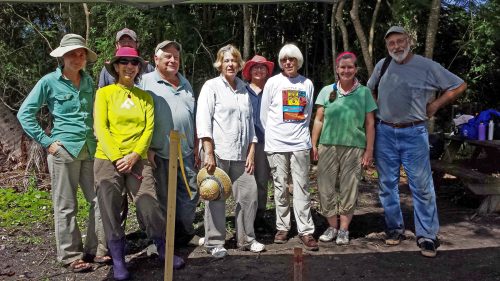
We began by positioning four shovel test holes, each about 35 cm in diameter, at the periphery of the proposed septic tank excavation, encountering dense shell midden at a depth of 10-15 cm in each test. We then dug two of the shovel test holes deeper to explore the stratification and help us plan the detailed excavation. Deposits in the test holes were screened through ¼-inch hardware cloth. In one of those holes, we used a post-hole digger to probe depths that were beyond arm’s length. The result was that the cultural deposits appeared to extend more than 106 cm beneath the surface, and well below water table. Un-charred wood was observed at 85 cm below surface and continuing into the lower depths.
We rented a pump and began a 1-x-1 meter excavation in the northeastern corner of the septic tank area, using one of the deeper shovel tests as a sump hole. Excavation was in 10-cm levels, with deposits screened through a series of nested screens, each with a finer mesh size: 4 mm, 2 mm, 1 mm, and 0.425 mm. We bagged the resulting sediments for later analysis by paleoethnobotanist Lee Newsom, our colleague at Pennsylvania State University who has studied Pineland’s ancient plant remains extensively (see page 1).
We completed the 1-x-1-m excavation on Tuesday, August 4. In addition to pottery sherds, shell tools, charred wood, fish and other animal bones, and many mollusk shells, the lower midden levels (85 cm and deeper) yielded extraordinarily well preserved wood (some showing evidence of having been shaped), twisted palm-fiber cordage, and what appear to be gourd-like squash seeds (probably Cucurbita pepo ) as well as seeds of wild plants such as saw palmetto and mastic. This degree of preservation is due to anaerobic conditions in waterlogged deposits that have not dried significantly since they were deposited.
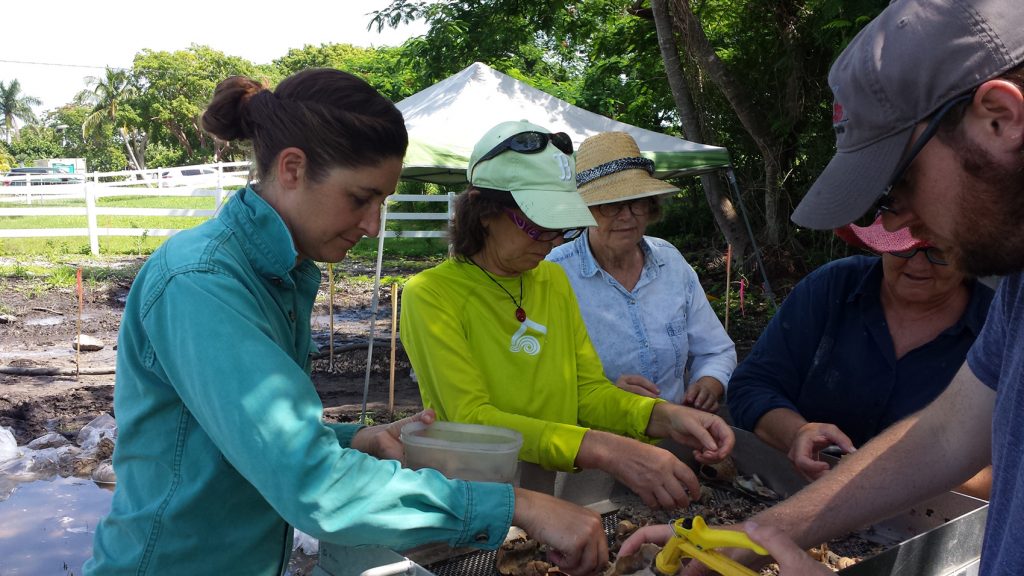
By prior arrangement, personnel from Honc Industries arrived the following day and removed upper midden material within the area of the proposed septic tank, stopping just above the level containing the waterlogged organic materials. At our request, the upper midden sediments thus removed were dumped at the Ruby Gill House back yard, where they will be sifted for artifacts by volunteers in the coming months. We then spent Wednesday afternoon preparing the excavation area — now approximately 6 square meters instead of 1 square meter — for further archaeological work.
On Thursday morning, August 6, we informed Honc foreman Pete Vanwageningen that we would require two more days of excavation to remove samples in the now-exposed lower midden levels for further study. He was most cooperative, agreeing to work elsewhere on the site in order to allow us time to remove these sediments in a controlled manner. This work included installation of pumping stations and cutting of two- inch-wide trenches to allow for piping sewage to the septic tank. We monitored and documented all machine excavations.
By Friday afternoon at 3:00 PM, we had completed the work we had proposed to do and more, and cleared the site for installation of the septic tank and drainfield on Saturday, August 8. The project was completed at 5:30 PM that day. I returned to Gainesville on August 9 to work on preparing for my fall teaching, but Karen stayed another week to work with volunteers to water-screen, re-bag, and organize our findings.
In all, we examined about 6 cubic meters of archaeological deposits. In addition to the artifacts, unburned wood, and seeds, we discovered a piece of knotted palm-fiber cordage that is almost surely part of a fish net. To my knowledge, this is the first preserved netting found in context since Cushing’s work at Key Marco. This is the second time we have encountered waterlogged we deposits at Pineland, but the first time we’ve actually found cordage with knots still tied in it. We also found an ark-shell net weight, with knotted cord still attached. A challenging aspect of the immediate and long-term care required for the unburned wood, seeds, cordage, and molluscan opercula is that these materials must be stored in water, preferably the same water that surrounded them before they were excavated.
From pottery clues, the deposits appear to date to about A.D. 500-600. Much analysis will have to be done before we are sure about any of the details, but one thing is clear: archaeological deposits with extraordinary preservation of organic materials comparable to those first unearthed by Cushing nearly 120 years ago are still buried deeply under Pineland’s surface. A more detailed report will be provided at a later time when some of the analysis and curation have been completed.
This research could not have been done without the corps of Randell Research Center (RRC) volunteers who showed up every day to work without compensation in quite difficult conditions of heat, humidity, and rain, and who continued assisting in the lab after the field work was done. RRC maintenance specialist Gary Vinson worked with us every day, providing help in many ways. Honc Industries personnel were courteous and responsive to our work. We very much appreciate the interest of the Randell family and their support of the expenses of this research. Additionally, Polly Eldred donated new plastic containers for the collection of plant related materials, and Tom Snodgrass donated a new Canon Power Shot camera to aid us in future projects.
This article was taken from the Friends of the Randell Research Center Newsletter Vol 14, No. 3. September 2015.
